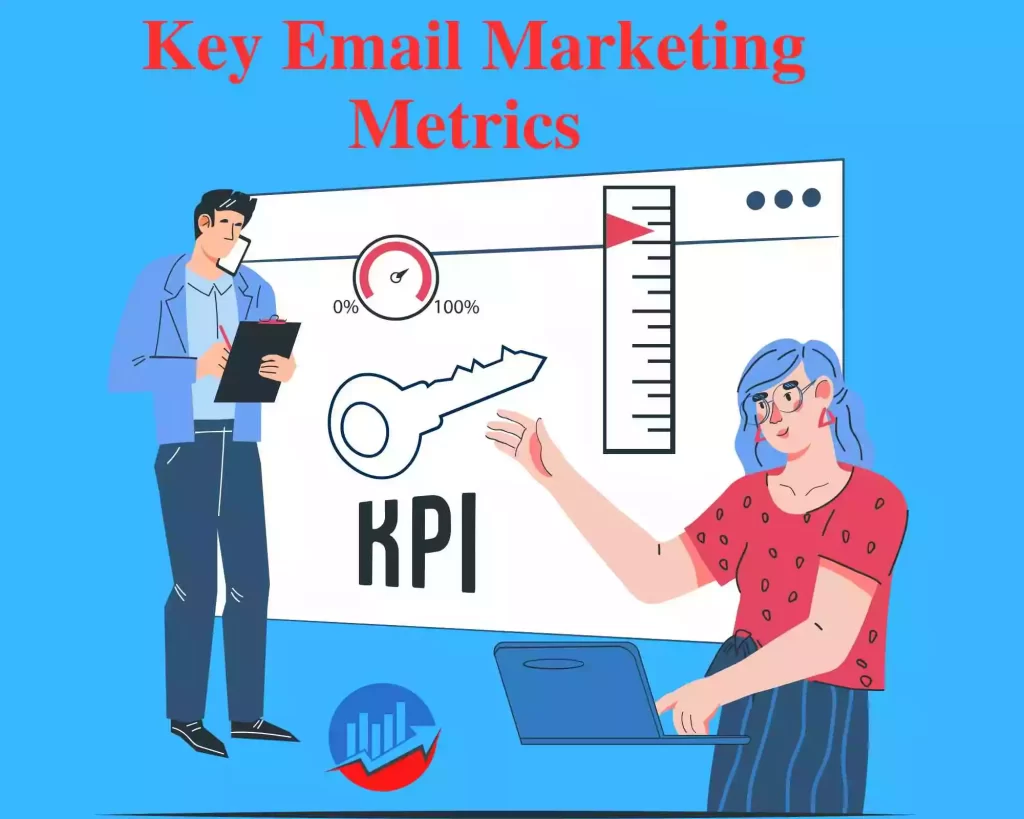Using the key email marketing metrics to track the performance of your email campaigns is very important.
Email marketing is a strong tool for organizations to contact their target audience, advertise goods or services, and generate conversions.
Yet, without tracking the right metrics, it will be hard to know the efficiency of your email marketing activities.
In this blog article, I’ll be exploring the 18 key email marketing metrics you should track to analyze the effectiveness of your email campaigns and enhance your entire marketing strategy.
Please read our guide on measuring your email campaign’s success.
Before we dive deeper into the world of email marketing metrics, let’s check out what email marketing metrics are
What Are Email Metrics?
The metrics used to track and evaluate the effectiveness of an email campaign are called email metrics.
These analytics provide illuminating details about the email campaign’s effectiveness, including the level of engagement, audience response, and overall success.
Let’s quickly review the benefits of keeping an eye on your email statistics.
Why You Should Track Email Metrics
Before we further study the 18 most important email marketing metrics, let’s briefly know why you should track email marketing metrics.
Tracking email metrics is important as it helps you understand how your email campaigns work and uncover improvement areas. Without monitoring your email metrics, you’re simply sending emails blindly without knowing how successful they are in engaging your audience or producing conversions.
Tracking email metrics also help you split your email list based on engagement levels. By identifying subscribers who frequently read and click your emails, you can develop customized campaigns that appeal to their specific interests and needs. This may enhance your conversion rates and subsequently earn more money for your organization.
For example, if you discover that your open rates are low, you may need to re-evaluate your subject lines or email content to make it more engaging. Similarly, if your email click-through rates are bad, you may need to alter your call-to-action (CTA) buttons or make your emails more visually beautiful.
Knowing where your troubles arise will help you address the problem and expand your audience. Now let’s check out the key email marketing metrics and KPIs you should track.
18 Metrics And KPIs To Track In An Email Marketing Campaign
1. Click Rate
Click-through rate is the proportion of email recipients that clicked on the link or any picture that includes the link in an email.
How to calculate click rate.
Click-through rate = (Total clicks or unique clicks/number of emails sent) * 100
Example: (1000 total clicks / 50,000 emails sent) * 100 = 2% click rate
Click through Rate allows you to see the performance of each email. CTR is typically used to assess A/B testing outcomes. These tests are generally meant to identify new methods to get emails to receive more clicks.
Important about click-through rate?
Upon executing an email marketing strategy, this Rate cannot be disregarded. Click-through rate is an essential indicator since it informs how your receivers respond to your content and delivery. From there, it may be changed to improve email efficiency.
2. Conversion rate
Conversion rate is the proportion of email recipients that perform a desired action after clicking a link in an email. The activity may be filling out a voucher registration form, downloading an ebook, etc.
How to calculate conversion rate.
Conversion rate = (Number of individuals performing action / total number of emails sent) 100
For example: (500 persons that performed the action/ 10,000 total emails sent) * 100 = 5% conversion rate
Conversion rate is one of the extremely significant indicators for measuring how successfully a marketing objective has been accomplished.
To assess this Rate, you must combine your email campaign management and website analytics tools. You may achieve this by defining unique pathways for email links to identify the source of clicks originating from a specific email campaign.
Important conversion rate?
As noted, if the purpose of your email marketing strategy is to produce leads via conversions, then measuring this Rate is vital.
3. Bounce Rate
Bounce rate is the proportion of emails sent out but failed to reach the receivers.
How to Calculate Bounce Rate
Bounce Rate = (Total number of bounces: Total number of emails sent) * 100
For example: (90 bounced emails: 5,000 total emails sent) * 100 = 1.8% bounce rate
Type of Bounce Rate
There are two kinds of bounce rate: hard bounce rate and soft bounce rate.
The hard bounce rate is the proportion of emails that are sent unsuccessfully to invalid or non-existent email addresses. You should delete these addresses from your email list since ISPs (internet service providers) will utilize this Rate as one of the elements that determine the email address’s reputation.
Soft bounce rate is the proportion of emails that are sent unsuccessfully because of transitory issues with a legitimate email address, such as a full recipient inbox or network connection difficulty, etc. For these instances, our server Receivers will store a cache of undelivered emails for delivery once the problem is repaired.
What is the importance of bounce rate?
While the goal of an email marketing campaign is not directly related to bounce rate, it is important to monitor it to ensure a “smooth” execution of the campaign. Your email address will look to be a spammer in the eyes of your ISP if you have a lot of bounced emails..
4. Deliverability Rate
The deliverability rate is the percentage of emails that arrive in the intended inbox.
How to calculate Deliverability Rate
Deliverability Rate = (Number of Junk Emails Delivered ÷ Number of Emails Delivered) * 100
Not all emails you send get delivered to the right destination, i.e., the mailboxes of users on your email list
Some of them may not arrive at their destination because the destination itself (email address) is no longer valid, while others, despite being delivered, end up in the spam folder.
What is considered a good deliverability rate?
While every marketer’s goal is to reach 100% of their subscribers, such absolute success is rarely achieved. It is important to note that the deliverability of emails also depends on the email platform.
95% or more is considered a decent delivery rate.
5. Listing growth rate
List growth is the pace at which the number of emails on your list increases.
How to calculate list growth rate
List Growth Rate = ( [Total New Subscribers – {Total Unsubscribes + Spam/ Complaint Emails}] : Total Email Addresses in the List) * 100
For example: (700 new subscribers – 350 unsubscribes and email/spam complaints) ÷ 5,000 list email addresses * 100 = 7% list growth rate
In addition to call-to-action metrics like click-through rate or conversion rate, you should measure the rise and decline in the number of addresses in your email list. This is vital to define the objective of extending the list to broaden the reach of the target audience.
Importance of list growth rate?
According to HubSpot. There is a natural decay of email marketing lists of roughly 22.5% every year. Therefore, you need to check this percentage often to develop a “healthy” list.
6. Email forward/share rate
Email forwarding or sharing rate is the proportion of receivers who click the forward button to send the message to another recipient or share the content on social media.
How to calculate email forward/ share rate
Email share/forward Rate = (Total share or forward button clicks: Total emails sent) x 100
For example: (200 share button clicks: 20,000 total emails sent) x 100 = 1% email share/forward rate.
This Rate may not appear crucial to the conversion objective, but it will give great value for you to attract more prospective clients. By encouraging recipients to share with like-minded individuals, you’ll uncover numerous “hot” connections.
Importance of email share and forward rates
By monitoring this ratio, you will find the material clients are most interested in and tend to share. Make use of this data source to boost the efficacy of your email marketing campaign strategy.
7. Complaints About Spam
If your target audience doesn’t know you or has forgotten you, and what’s more, they find your email annoying or offensive, your email is likely to be flagged as spam.
Email service providers want to maintain quality and try to track spam complaints. Your email service provider will likely take action against you and block you if your spam score is too high.
How to Calculate Spam Complaint
Spam Complaint Rate = (Number of spam complaints ÷ Number of emails delivered) * 100
How Should Low Spam Complaints Be?
A spam complaint rate of less than 0.1%, or one complaint per 1,000 messages delivered, is considered acceptable in many industries. Any higher value is considered alarming.
8. Overall ROI
Overall ROI is the total return on investment for an email marketing campaign. Or it might be defined as the ratio of total revenue spent to total expenses
How to calculate overall ROI
Total ROI = [ (Additional sales produced – Email campaign investment cost): cost spent in the campaign ] x 100
For example [ ($2,000 in extra income – $200 in campaign investment): $200 in campaign investment ] × 100 = 900% return on campaign investment
There are various methods to calculate ROI based on the kind of company. This is the most basic formula you may use to calculate.
Importance of ROI
By calculating ROI, you will know the real income, the efficacy of the channel, etc., so you can analyze the success of the campaign and improve the movement more effectively.
9. Open Rate
Open Rate is the proportion of receivers who open an email. Most firms are seeking to optimize subject lines that are interesting and enticing to inspire greater open rates.
How to calculate open Rate
Open Rate = (Total email opens / number of emails sent) * 100
Example: (1000 total opens / 50,000 emails sent) * 100 = 2% click rate
Nevertheless, the reason why this % is a highly deceptive indicator is that each email is only considered as “opened” only if the receiver also gets the picture in that email.
Recipients may entirely utilize the picture-blocking option to refuse to see photos on the program. This indicates that this ratio is not truly accurate. If you simply assess the campaign using this ratio, it is not feasible to evaluate the effectiveness of the campaign.
Importance email open rate?
Using this ratio you may utilize it for comparison. For example, compare this week’s email delivery rate with the previous week’s (with the same list) to evaluate whether your delivery is relevant.
10. Email open Rate on mobile devices
Given their simplicity and compactness, nowadays, mobile phones are vital equipment for everyone.
According to today’s data, the number of people using mobile devices nowadays is 60% more than the number of people using desktop computers. Consequently, tailoring emails with a suitable design on mobile devices to target the demographics mentioned earlier can dramatically boost the click-through rate.
You may optimize your emails from basic measures such as: modifying the font size, using less text in the email, using photos that are light, quick to load, and notably do not utilize the In addition, you need to keep the email topic brief, ideally fewer than 35 characters.
11. Unsubscribe rate
The unsubscribe rate is the proportion of email subscribers that unsubscribe after opening a given email.
What is the importance of the unsubscribe rate?
Although this Rate isn’t directly tied to your campaign’s objectives, tracking it will be beneficial for assessing total email list growth.
12. Time to open mail
Selecting an acceptable time to send an email is quite crucial. Thus you should pick a day and time to email to fit your consumer group.
For example, Your customers are normal people who receive a lot of emails every day, so when you send emails during office hours, chances are your mail will be sent at the same time as their important work emails, and then Your email will be pushed down, and customers will not remember to read the email you sent.
13. Email reading time
The metrics used to explicitly measure how much time users spend seeing your emails depends on the email service provider (ESP) you’re using.
Email reading time is separated into 3 categories:
- >8 seconds: read
- 3-8 seconds: skimming
- <2 seconds or less: glance
When beginning to monitor consumer email watch time, a skim and glance percentage below 25% is a good indicator, although this may still fluctuate based on the sort of email you send. And based on this outcome, you may also determine whether your email content genuinely attracts clients.
14. Subscriber list growth rate
With aims such as: drawing more subscriptions, enticing numerous free users, generating visitors to the site, etc. And, of course, the growing pace of the subscriber list will reflect achieving these targets. With this ratio, you will measure the efficacy of the campaign with the aim you are seeking.
15. Error Rate
The number of errors, from broken links to grammatical mistakes, customization errors to automation errors, is determined by this metric.
How to calculate Error Rate
Error Rate = (Monthly number of emails sent with an error ÷ Monthly number of emails sent) x 100
16. Over Time Engagement
The optimal times of day to deliver messages may be determined by monitoring engagement over time.
You may use automation in your email service provider to send emails in response to client behavior or other triggers, but monitoring engagement over time will reveal when non-automated emails have the best clickthrough rates.
Several email service providers have this capability automated and will compile the information for you. It’s not a terrible idea to monitor this parameter on your own and figure out the ideal send times for your sector and subscriber base.
17. Amount of new leads (or total) produced
If your email marketing campaign’s aim is lead creation, you should measure the number of leads (leads) every day, every month, to improve lead generation.
18. Lead-to-customer conversion rate
Assuming you concentrate more on conversions. The email content is “decorated” with numerous CTAs, then focuses on the conversion rate of prospective customers.
In addition, the proportion of no longer active subscribers (emails that are no longer active) is also essential. This ratio is vital to keep an eye on since sending emails to several inactive addresses decreases the authority of your email account. At the same time, when the email address has too low engagement, it will impact the capacity to send emails. Emails will still technically be sent but not necessarily viewed, i.e., to the recipient’s “spam” folder.
Conclusion
Without tracking most of these 18 email marketing metrics, it will be difficult to accurately measure your efforts, leaving you in perpetual uncertainty about how to improve your email campaigns.
Insights into these metrics help you improve your emails, turning you into an expert marketer.
Therefore, invest time and effort into these metrics and KPIs to take corrective action and bring your team together to improve the results of your email campaigns.





